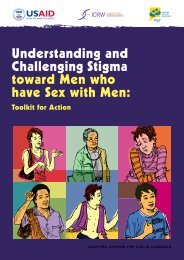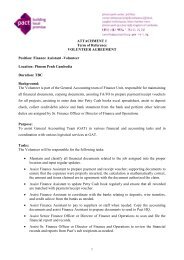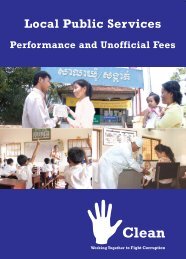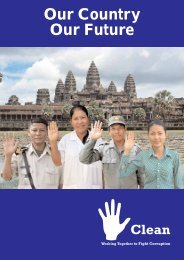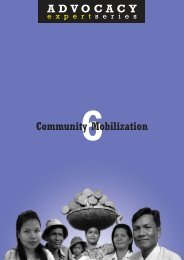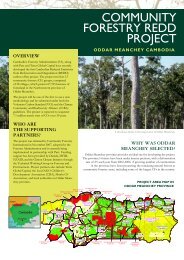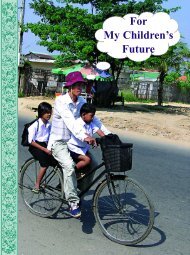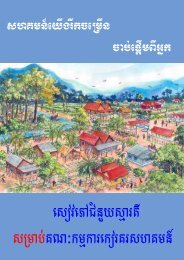Advocacy in Cambodia: Increasing Democratic ... - Pact Cambodia
Advocacy in Cambodia: Increasing Democratic ... - Pact Cambodia
Advocacy in Cambodia: Increasing Democratic ... - Pact Cambodia
Create successful ePaper yourself
Turn your PDF publications into a flip-book with our unique Google optimized e-Paper software.
labor<br />
The garment factory labor movement<br />
presents an <strong>in</strong>terest<strong>in</strong>g example of advocacy<br />
<strong>in</strong>volv<strong>in</strong>g the three sectors of society - government,<br />
private sector, and civil society. 1 Characteristics<br />
of the movement <strong>in</strong>clude hav<strong>in</strong>g a specific<br />
objective (improv<strong>in</strong>g garment workers’<br />
employment conditions), and benefit<strong>in</strong>g from the<br />
<strong>in</strong>stitutional support of local and <strong>in</strong>ternational<br />
organizations.<br />
Garment Industry and Organized Labor<br />
<strong>in</strong> <strong>Cambodia</strong><br />
Overview of Garment Industry<br />
<strong>Cambodia</strong>’s first garment factories were<br />
established <strong>in</strong> the mid-1990s and by the end of<br />
the decade more than 200<br />
factories were operat<strong>in</strong>g <strong>in</strong> the<br />
country. In 1999, the garment<br />
<strong>in</strong>dustry accounted for 15% of<br />
the GDP. The success of the<br />
<strong>in</strong>dustry is due <strong>in</strong> large part to<br />
the Multi-Fiber Agreement<br />
negotiated by the World Trade<br />
Organization, which provides<br />
quotas for <strong>Cambodia</strong> to export<br />
garments to the U.S. To<br />
highlight the importance of the<br />
<strong>in</strong>dustry, <strong>in</strong> 1999, 78% of all<br />
official exports were garments.<br />
Most garment factories are<br />
foreign-owned, usually by Asian bus<strong>in</strong>esses that<br />
have contracts from large, global companies.<br />
These bus<strong>in</strong>esses are attracted to <strong>Cambodia</strong>’s<br />
abundant low-skilled and low-wage work force.<br />
The 1997 Asian f<strong>in</strong>ancial crisis resulted <strong>in</strong> a slight<br />
decrease <strong>in</strong> demand and up to 40 factories ceased<br />
operation dur<strong>in</strong>g that time. Bus<strong>in</strong>ess has improved<br />
slightly s<strong>in</strong>ce, and today the garment sector<br />
employs an estimated 180,000 workers. The large<br />
majority of workers are young women aged 18 to<br />
25 who have moved to Phnom Penh from rural<br />
areas to seek relief from poverty. Their youth, and<br />
the fact that they are far from their homes, places<br />
them <strong>in</strong> a vulnerable position and they are unlikely<br />
to become politically active outside of assert<strong>in</strong>g<br />
their rights at work.<br />
The Garment Manufacturer’s Association of<br />
In 1999, the garment<br />
<strong>in</strong>dustry accounted for<br />
15% of <strong>Cambodia</strong>’s GDP,<br />
and 78% of all official<br />
exports were garments.<br />
<strong>Cambodia</strong> (GMAC) was established <strong>in</strong> 1997 to<br />
organize all export garment factories under one<br />
umbrella. GMAC aims to protect the right of<br />
<strong>in</strong>vestors to do bus<strong>in</strong>ess <strong>in</strong> <strong>Cambodia</strong> accord<strong>in</strong>g<br />
to the law. The association, which currently has<br />
193 members, acts as a liaison between garment<br />
factories and government agencies, and is a<br />
member of the Labor Advisory Committee chaired<br />
by the M<strong>in</strong>istry of Labor. GMAC statutes require<br />
that members complete a company profile,<br />
demonstrate proof of registration, and pay dues<br />
on time. Members are encouraged, but not<br />
required, to participate <strong>in</strong> the International Labor<br />
Organization (ILO) garment sector monitor<strong>in</strong>g<br />
project.<br />
As part of its activities, GMAC provides<br />
<strong>in</strong>struction to members on labor issues and<br />
ma<strong>in</strong>ta<strong>in</strong>s a database of<br />
activities on the labor<br />
movement. GMAC also<br />
ma<strong>in</strong>ta<strong>in</strong>s a tra<strong>in</strong><strong>in</strong>g center<br />
with assistance from Japanese<br />
experts and which receives<br />
advice from the M<strong>in</strong>istry of<br />
Commerce. The tra<strong>in</strong><strong>in</strong>g<br />
center’s goal is to upgrade the<br />
supervisory skills of staff from<br />
member companies.<br />
Organized Labor <strong>in</strong> the<br />
Garment Industry<br />
<strong>Cambodia</strong>’s labor<br />
movement was born <strong>in</strong> 1993 with the enactment<br />
of the Constitution, which for the first time<br />
allowed people to form unions. 2 Organized labor<br />
ga<strong>in</strong>ed momentum at the end of 1996, when the<br />
first labor union, the Free Trade Union of Workers<br />
of The K<strong>in</strong>gdom of <strong>Cambodia</strong> (FTUWKC) was<br />
formed, and soon after 3,000 garment workers<br />
marched to the National Assembly demand<strong>in</strong>g<br />
better work<strong>in</strong>g conditions. An <strong>in</strong>dicator of how<br />
poor work<strong>in</strong>g conditions must have been prior to<br />
the labor movement is the fact that workers who<br />
participated <strong>in</strong> the first demonstration were<br />
mak<strong>in</strong>g one-third of what was to become the legal<br />
m<strong>in</strong>imum wage.<br />
Strik<strong>in</strong>g workers did w<strong>in</strong> some concessions<br />
from the Malaysian-owned company they were<br />
strik<strong>in</strong>g aga<strong>in</strong>st, although they encountered a<br />
Case Studies<br />
59




